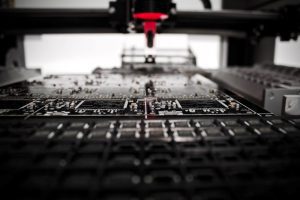Anyone who has ever created a PCB knows the arduous process of designing, testing, and redesigning it requires. Another important consideration is the initial choice of how you will carry out PCB manufacturing. For any given project, PCB assemblers have two options: turnkey manufacturing and consignment manufacturing.
What’s the difference between these two forms of PCB manufacturing? Which approach is best for your project? Let’s take a look below.

(Louis Reed/Unsplash)
Turnkey PCB Manufacturing Explained
Turnkey manufacturing is when a project gets outsourced to a PCB assembly company. The designer gives the blueprints and design specs to a chosen business which then puts it into production. The business’s job is to gather the resources and components and assemble them into a prototype.
The business then tests the prototype, makes modifications and improvements, and outputs the final product. The business handles all of these costs and processes without any monetary input from the designer. They keep the original designer in contact with the business through a chosen go-between but otherwise have little input on manufacturing decisions.
The Benefits of Turnkey PCB Manufacturing
Keeps new PCBs in the competition
The development of new PCBs is a rush at the best of times. Technology advances at an alarming rate, and it doesn’t take long for new products to outclass the old. By utilizing turnkey manufacturing, prototype and new-build PCBs are output at a quick rate. This keeps new designs current and ahead of the competition.
Handles each step in the manufacturing process
With all aspects of the project outsourced, there is no pressure on the original designer to handle it. All components, materials, storage, and shipping costs are under the control of the business, taking all the pressure off the designer.
Professionals handle the project
Outsourced jobs go to businesses that already exist in the PCB production industry. Most manufacturing companies can be relied on for having experience and hiring professional engineers. This means the designer can expect the outsourced work to meet high levels of quality.
The Downsides of Turnkey Manufacturing
No hands-on control
Once a PCB design is given to an outsourced business, the designer has little control. While occasional updates and requests might be relayed through contact within the business, ultimately, it is no longer the designer’s project.
Reliant on the work of others
While most PCB manufacturing businesses are reliable, it takes a fair understanding of each one to determine which is best. This means there is always a chance that the chosen business will not meet the desired quality and skill expectations.
Production happens according to the business’ schedule
There may be a significant delay between submitting a PCB design and the commencement of production. The manufacturing business will only begin the production process when they can, which could mean delays if they are currently working on other projects.
Consignment Manufacturing Explained
Where turnkey manufacturing puts the entire process of building a new PCB design in the hands of others, consignment does the opposite. With consignment manufacturing, the entire process of building and testing the new PCB design is given wholly to the designer.
This is essentially in-house PCB assembly, as the designer will be responsible for every process step. They will procure every necessary component, manage and perform the assembly and testing of the board, and then handle storing and shipping it. This isn’t necessarily a solo endeavor, as the designer may already be part of a manufacturing team. It simply means that the designer does not give the PCB designs to anyone outside their control.
The Benefits of Consignment Manufacturing
Complete control over the project
As the project will not be handed off to another team, the designer of the new PCB build has complete control. They oversee as much (or as little) of the project as they wish, and often manufacturing teams will defer to them for any changes that may occur. This is the best option for anyone unwilling to relinquish control of their project or anxious that it stick within their designs.
Immediate start to manufacturing
Production of an in-house PCB build begins as soon as the designer is ready. If the necessary components and employees are already on hand, production can begin as soon as the designs are completed. The same is true for any alterations that must be made to the project, as they can be found and handled as they arise.
No need to trust a third-party manufacturer
When production happens in-house, the designer and their team (if they have one) handle the whole operation. This is especially useful if the team they’re using is one whose work they already know and trust.
The Downsides of Consignment Manufacturing
All costs must be covered
This is fine if the design comes from within a PCB manufacturing company, as the infrastructure for production will already be in place. However, the costs can be a sticking point for any designer working solo or just starting in the industry. Locating and buying every component can be costly, as are the production, storage, and shipping costs incurred during production. Turnkey manufacturing has all these costs deferred to the business hired to perform the work.
The designer and their team must deal with issues personally
As with costs, any time an issue arises – either in tests, with the manufacturing process, or any other part – these must be handled by the production team. For an inexperienced or tightly-budgeted team, this can be a disaster.
Turnkey vs. Consignment: Which Is Best for My PCB Project?
Capability is the main consideration for whether a PCB project should be outsourced to a turnkey company or done in-house. Any company with the infrastructure, staff, and components to produce a new PCB design is better off doing so. However, this is only sometimes the case. If issues of cost, experience, or time are pressing, it is better to hand the project off to a dedicated PCB production business or EMS provider.
